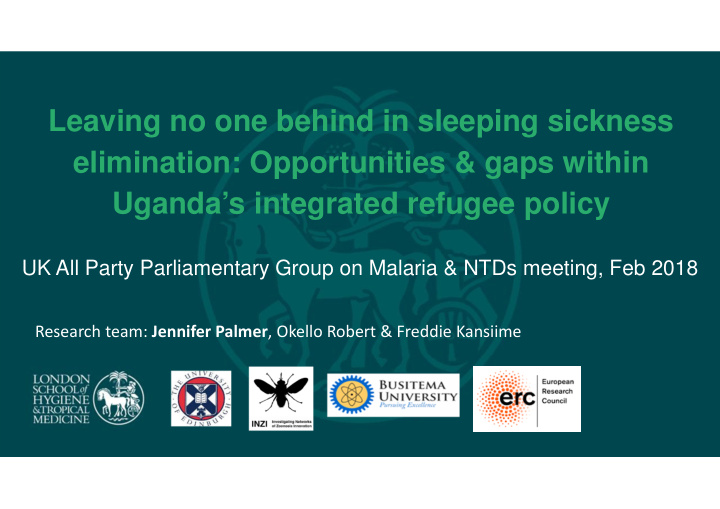



Leaving no one behind in sleeping sickness elimination: Opportunities & gaps within Uganda’s integrated refugee policy UK All Party Parliamentary Group on Malaria & NTDs meeting, Feb 2018 Research team: Jennifer Palmer , Okello Robert & Freddie Kansiime
Sleeping sickness & forced migration • Affects mind & body, fatal without treatment • Outbreaks associated with conflict & forced migrations • Humanitarian agencies historically important actors • MSF treated 30% of cases at epidemic peak MSF 4 th largest R&D donor • • All endemic countries host forcibly displaced populations
Sleeping sickness elimination: a changing landscape Nascent elimination targets & guidelines New actors • 1 st sleeping sickness target in 2012 • Belgian govt, Gates Fdn, Product Development Partnerships (DNDi & FIND, New technologies & strategies both part-funded by DFID) • 1 st sleeping sickness RDT, oral drugs, Fewer cases, more displacement tsetse control innovations • Natl program staff responsible for all: • Half of cases detected through ‘research’ control / research, refugees / host pop 50,000 Sleeping sickness 40,000 cases 30,000 20,000 10,000 0 1945 1950 1955 1960 1965 1970 1975 1980 1985 1990 1995 2000 2005 2010 2015
Forced migration to Uganda South Sudan Promising policy context: - Refugees served in govt health facilities - Sleeping sickness RDTs available in Sleeping DR Congo sickness govt health facilities cases (2000-9) …but challenges… Since 2013: • 1 million refugees • 19 sleeping sickness cases in northwest Uganda, including refugees Uganda
Programmatic challenges during refugee influx 1. Unbalanced international financial support to government services • UNHCR prioritises primary healthcare • Little $$ to expand vertical programmes 2. Sleeping sickness coordination staff reluctant to engage humanitarian coordination structures 3. Rapid expansion of health teams � sleeping sickness RDT knowledge & norms lost 4. Difficulties screening for a rare disease through different languages & cultures � � RDTs hardly Little surveillance No cases to In refugee settlements: used data produced prompt suspicion
Availability of RDTs 5. No international guidance on acceptable rate of RDT use for elimination 6. Perceived pressure to demonstrate value for money • Program cost to add/keep an RDT facility: $300/a 2013 7. Momentum of original plan: • Withdraw surveillance resources (as quickly as possible) in areas judged to have low disease risk Programmatic outcomes • Surveillance gaps in some areas densely populated by refugees 2016 • Opinion of refugees: access to sleeping sickness tests better before displacement
More information:
Gaps in the evidence base Gaps in policy work • How best to serve forcibly-displaced • How to conceptualise the responsibilities of populations in an elimination context? host governments & partners towards refugees during elimination? • What level of case detection (reach & • How to support/incentivise host governments quality) is needed to verify elimination? & partners to anticipate needs of displaced • How best to monitor elimination equity populations during elimination? between host & displaced populations? Implications for DFID � Clear governance gap in supporting elimination of HAT (and potentially other NTDs) in fragile states and forcibly displaced populations
Recommend
More recommend